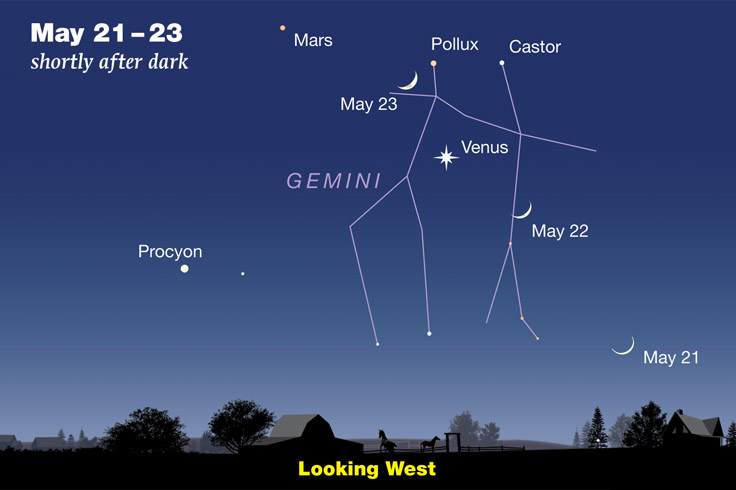This month’s episode takes you on a guided tour of the key stars and planets that you’ll see on May evenings — a fun and informative way to introduce yourself to the nighttime sky!

Listen Here:
Podcast: Play in new window | Download
Subscribe: Apple Podcasts | Google Podcasts | Spotify | Email | RSS | More
In this month’s episode of our long-running Sky Tour astronomy podcast, we’ll look for tiny bits of Halley’s Comet, track down a couple of evening planets, and take stock of bright stars in the late-spring sky.
Each year about this time, planet Earth glides across the orbit of Halley’s Comet, and when that happens we run into rocky grit shed by the comet centuries ago. Astronomers call this annual cosmic light show the Eta Aquariid meteor shower. Now, since Aquarius isn’t in the evening sky right now, to enjoy this shower you’ll need to get up a couple of hours before dawn on May 6th, say, 3 a.m. Be forewarned that this year’s show will be spoiled by the distracting light from a nearly full Moon.
As May opens, there’s a fat gibbous Moon in the evening sky, and it becomes full on the 5th. On evenings after that the Moon rises about an hour later each night. So by May 12th, when the Moon is at last quarter, it doesn’t rise until well after midnight — thanks in part to daylight saving time. New Moon follows on May 19th, and a few days later you’ll find a thin crescent hanging over the western horizon as darkness falls. First quarter follows on the 27th, and by month’s end the Moon is once again nearly full.

Sky & Telescope
At nightfall in early May, the western half of the sky is littered with bright stars. For example, look for a bright beacon just peeking over the southwestern horizon. This is Sirius, the brightest star in the nighttime sky. Slide your gaze toward the right, and you’ll come to Betelgeuse. Higher up, above Sirius, is Procyon, and well to its right, past Venus, is the bright star Capella. Together with Castor and Pollux, these stars are the last vestiges of wintertime constellations that are past their expiration dates and sinking into the western twilight.
Much higher than all of these, about two-thirds of the way to overhead, is Regulus, the alpha star in the constellation Leo, the Lion. Regulus sits at the bottom of a star pattern called the Sickle, because it looks like the hand tool with a curved blade used for harvesting crops. Regulus is at the bottom of the handle. It’s about the size of your clenched fist. Or maybe you’ll see it more easily if you look for a question mark facing the wrong way. In any case, the stars of the Sickle trace out the head of Leo, Regulus marks the lion’s heart, and its body extends off to the left.
This month’s podcast has much more to say about the stars and constellations in view this moth, so why not give it a listen? It’s a fun and informative way to introduce yourself to the nighttime sky, no matter what your level of experience. So download or stream this month’s 12-minute Sky Tour, then head outdoors to enjoy what the night sky has to offer.
 0
0
Comments
You must be logged in to post a comment.